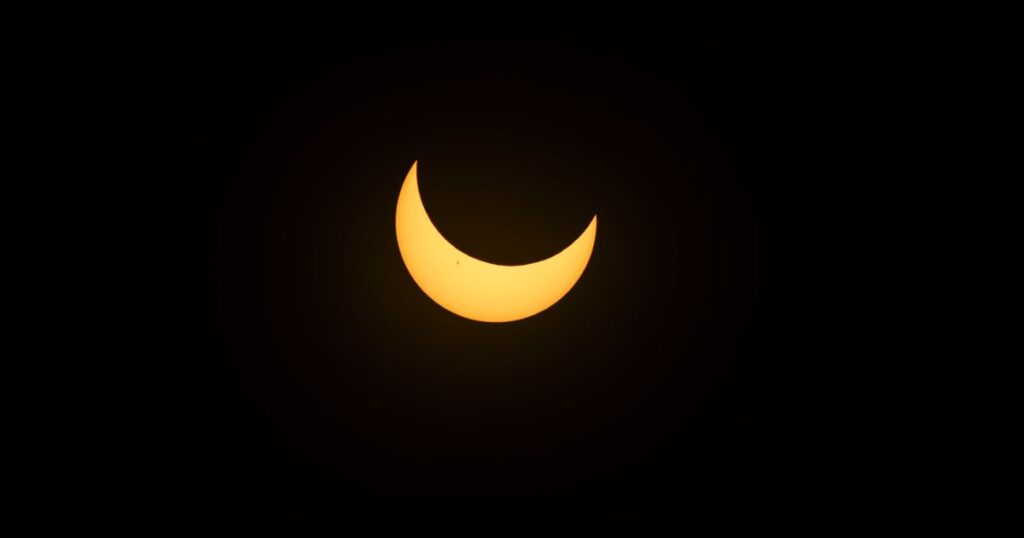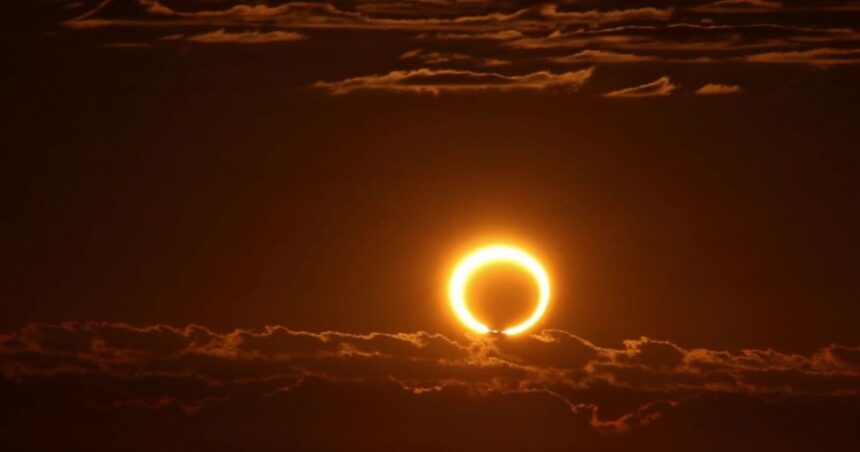The Annular Solar Eclipse is on October 2. This special eclipse will be visible in many parts of the world. It is an exciting event for skygazers; they can see the rings of fire during a solar eclipse.
When does a solar eclipse occur? It occurs when the Moon passes between the Sun and the Earth. There are four types of Solar eclipses: Total Solar Eclipse, Partial Solar Eclipse, Annular Solar Eclipse, and Hybrid Solar Eclipse.
On October 2, an Annular Solar Eclipse is happening, in which the Moon is in between Earth and Sun, but the Moon is farther away from Earth. This makes the Moon look smaller than the Sun. So, it doesn’t cover the Sun completely. Instead, it creates a bright ring around the Moon known as the “ring of fire.”
When and Where to Watch
The timing of the Solar Eclipse depends on your location so a eclipse will start at a different time from where you are. The partial eclipse begins at 15:42 UTC. The annular phase, where you can see the “ring of fire,” starts at 16:50 UTC.
The maximum eclipse, when the ring is the most visible, happens at 18:45 UTC. The Annular phase ends at 20:39 UTC, and the partial eclipse ends at 21:47 UTC.
This annular solar eclipse will be visible in parts of South America, the South Pacific Ocean, the Atlantic Ocean, and Antarctica. If you are in Argentina or Chile, you are lucky! These countries will have a great view of the annular eclipse.
Other places like Brazil, Chile, Christmas Island, Falkland Islands, Hawaii, USA, New Zealand, Palmyra Atoll, U.S. Minor Outlying Islands, Samoa, Tuvalu, South Georgia and South Sandwich Islands, Paraguay, Mexico, French Polynesia, Pitcairn Islands, Uruguay, Cook Islands, Clipperton Island, Tokelau, Niue, Fiji, Tonga, Wallis and Futuna, people will see a partial solar eclipse.

A solar eclipse is a pleasure to watch. But it is equally important to take care of your eyes. Never look directly at the Sun with naked eyes while viewing a solar eclipse. You need special eclipse glasses or a solar viewer. Regular sunglasses are not safe. Looking at the Sun without protection can damage your eyes.
During the annular solar eclipse, the sky will get a bit darker. It won’t be as dark as night, but you will notice a change. The temperature might drop a little, too. Birds and animals might get confused and think it’s evening. It’s a unique experience for everyone.
How to Prepare
If you want to watch the annular solar eclipse, here are some tips:
- Find a Good Spot: Choose a place with a clear view of the sky. Avoid areas where there are too many tall buildings or too many trees to view the solar eclipse.
- Check the Weather: Make sure the weather will be clear on October 2. Clouds can block your view of the eclipse.
- Get Your Gear: Buy eclipse glasses or a solar viewer in advance. Don’t wait until the last minute.
- Plan Your Time: Note the times of the eclipse phases. Be ready to watch from the beginning to the end.
Solar eclipses remind us of the wonders of our universe. They show us how the Sun, Moon, and Earth interact. Each eclipse is different and offers a new experience. Watching an eclipse can make you feel connected to the cosmos.
Fun Facts About Eclipses
- Eclipse Chasers: Some people travel around the world to see solar eclipses. They are called eclipse chasers. They plan their trips to be in the best spot to see the eclipse.
- Ancient Beliefs: In ancient times, people had many beliefs about eclipses. Some thought they were a sign of bad luck, and others believed they were messages from the gods.
- Eclipse Cycles: Solar eclipses happen in cycles. One famous cycle is the Saros cycle. It lasts about 18 years. After this time, similar eclipses happen again.
The annular solar eclipse on October 2, 2024, is a must-see event. Remember to stay safe and enjoy the show. Whether you see the full “ring of fire” or just a partial eclipse, it’s a sight you won’t forget.
So, take advantage of this celestial event. Gather your friends and family, and share the wonder of the annular solar eclipse. Happy eclipse watching!
Editor’s Recommendations
- Once-in-a-Lifetime Event: Corona Borealis Constellation Shine Brighter as Nova Explosion
- Hubble’s Shocking Discovery, Supermassive Black Hole Jets Trigger Explosive Novas
- Annular Solar Eclipse on Oct. 2, Witness the Sky’s Fiery Ring at Breakneck Speed
- Once-in-a-Lifetime Event: Corona Borealis Constellation Shine Brighter as Nova Explosion





